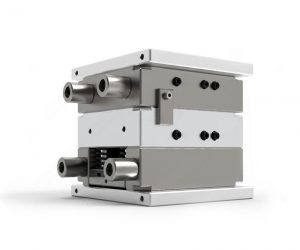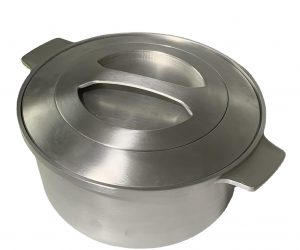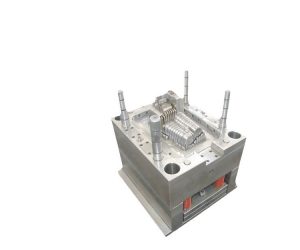Let's delve into the fascinating realm of aluminum mold injection molding. We'll uncover its benefits, uses, and various facets related to employing aluminum molds in this process. You'll learn about the types of aluminum used for these molds, why plastic flows more smoothly in them, and which molds are top-notch for aluminum casting.
Aluminum injection molding is a cutting-edge manufacturing technique that leverages the unique properties of aluminum to craft intricate plastic items. It boasts several perks over conventional plastic injection molding. For starters, aluminum is a great heat conductor, swiftly dissipating heat from the mold and slashing cooling times. This boost allows aluminum mold injection molding to ramp up production efficiency and quicken cycles.
Moreover, aluminum melts at a lower temp and exhibits excellent fluidity, facilitating easier plastic flow and filling within the molds. This minimizes defects and enhances product quality. Plus, aluminum's resistance to corrosion and wear extends the lifespan of the molds, reducing replacement frequency and costs.
Picking the right aluminum alloy is crucial when using aluminum molds for injection molding. Popular choices include 6061, 6063, and 7075, known for their robustness, hardness, and ease of shaping, perfect for crafting complex plastic goods.
Beyond material selection, a well-thought-out aluminum mold design is vital for injection molding triumph. The design should factor in plastic flow, filling speed, and cooling impact. Smart mold design curbs defect occurrences, elevating product quality and consistency.
In essence, aluminum mold injection molding stands as an efficient, dependable method for producing a wide array of intricate plastic items. By grasping its strengths, applications, and associated factors, we can make informed decisions on aluminum mold usage, enhancing both productivity and product excellence.
Introducción
Injection molding is a popular way to make plastic parts and components. How good and fast the process is depends largely on the molds used. Lately, aluminum molds have become really popular because they have many advantages over other mold materials. In this article, we'll look at why aluminum molds are great for injection molding and talk about the different types of aluminum used for these molds.
The Advantages of Aluminum Molds
2.1 Light and Strong
Aluminum molds are really light yet super strong. This mix helps a lot during the plastic injection process. Being lighter makes them easier to handle and switch out quickly, which speeds up production. Plus, their strength means they last longer, saving money over time.
2.2 Better Heat Handling
Aluminum is great at spreading heat, even better than steel. This helps keep the temperature just right during molding. It stops parts from warping and keeps them precise, so everything fits perfectly.
2.3 Quick Turnaround
Aluminum molds can make things faster. They heat up and cool down quickly, which means the plastic sets fast too. This cuts down the time it takes to make each part. Faster cycles mean more products, meeting tight schedules and market needs.
2.4 Money-Saving
Using aluminum molds saves cash in several ways. First off, they're cheaper to start with than steel ones. That makes them perfect for testing new designs or small batches. The quick cycles also boost productivity and lower running costs. And since they're light, moving and shipping them is cheaper too.
Types of Aluminum Used for Molds
3.1 6061 Aluminum Alloy
One commonly used aluminum alloy for molds is 6061. It is a versatile alloy with excellent machinability, corrosion resistance, and moderate strength. 6061 aluminum is suitable for a wide range of applications and is readily available in the market. Its favorable combination of properties makes it an ideal choice for aluminum molds used in injection molding processes.
3.2 7075 Aluminum Alloy
If higher strength is required, 7075 aluminum alloy is often preferred. It exhibits excellent strength-to-weight ratio and good machinability. 7075 aluminum molds can withstand high-pressure conditions and are suitable for producing parts with complex geometries or thicker walls. However, it is worth noting that 7075 aluminum alloy molds may be more expensive compared to other aluminum alloys.
5083 aluminum alloy is commonly used for molds requiring superior corrosion resistance. It possesses excellent weldability and formability, making it suitable for intricate mold designs. 5083 aluminum alloy molds are often used in industries such as automotive, aerospace, and marine, where exposure to harsh environments is common.
Why Plastic Flows Better in Aluminum Injection Molds
4.1 Thermal Conductivity
One of the primary reasons plastic flows better in aluminum injection molds is the high thermal conductivity of aluminum. During the injection molding process, the plastic material needs to be heated to its melting point and then cooled rapidly to solidify. Aluminum molds excel in efficiently transferring heat, enabling precise temperature control. This results in consistent and uniform flow of molten plastic, minimizing defects and ensuring better part quality.
4.2 Lower Melting Point
Compared to other common mold materials like steel, aluminum has a lower melting point. The lower melting point of aluminum allows for lower injection molding temperatures, reducing energy consumption and cycle times. Additionally, lower temperatures also help mitigate the risk of thermal degradation of the plastic material.
4.3 Reduced Cooling Time
Aluminum molds possess excellent thermal conductivity, which promotes faster heat dissipation. The rapid cooling capability of aluminum molds leads to reduced cooling times during the injection molding process. The shorter cooling time ensures quicker solidification of the plastic material, enabling faster production cycles and improved productivity.
The Best Mold for Aluminum Casting
When it comes to aluminum casting, permanent molds made from steel or other materials are typically used. The selection of the best mold for aluminum casting depends on factors such as the complexity of the part, desired surface finish, production volume, and budget. Permanent molds made from steel offer excellent durability and precision but may have higher upfront costs. On the other hand, aluminum molds, although less durable, can be a cost-effective option for low-volume production runs or prototyping.
Conclusión
Aluminum molds have indeed transformed the injection molding landscape, offering a blend of benefits that cater to modern manufacturing demands. Their lightweight nature facilitates easier handling and quicker mold changes, while their durability ensures a prolonged lifespan, translating into long-term cost savings. These advantages are further complemented by aluminum's superior heat conductivity, which promotes efficient temperature regulation during the molding process, minimizing defects and enhancing part quality.
The ability of aluminum molds to expedite cycle times is a game-changer in high-volume production environments. Rapid heating and cooling cycles not only boost productivity but also enable manufacturers to meet tight deadlines without compromising on quality. This efficiency directly impacts operational costs, making aluminum molds an economically viable option for both prototyping and full-scale production runs.
Selecting the appropriate aluminum alloy is crucial in harnessing these benefits fully. Different alloys offer varying levels of strength, corrosion resistance, and thermal conductivity, allowing manufacturers to tailor their molds to specific application needs. For instance, alloys with enhanced wear resistance might be preferred for long-production runs, whereas those with excellent thermal properties could be ideal for intricate designs requiring precise temperature control.
In contrast, permanent steel molds, though heavier and typically more expensive initially, excel in applications demanding extreme durability and very high production volumes. They are less prone to wear and tear compared to aluminum and can withstand harsher operating conditions, making them suitable for mass-produced parts over extended periods.
Ultimately, the decision between aluminum and steel molds hinges on a careful analysis of factors such as production volume, part complexity, budget constraints, and desired part quality. Aluminum molds shine in scenarios where rapid prototyping, moderate to high production volumes, and cost-effectiveness are prioritized. On the other hand, steel molds remain the go-to choice for large-scale manufacturing where durability under heavy use is paramount. By carefully evaluating these aspects, manufacturers can make informed decisions that optimize both performance and cost-efficiency in their injection molding operations.
Frequently Asked Questions
7.1 What is the best mold for aluminum casting?
The best mold for aluminum casting depends on factors such as the complexity of the part, desired surface finish, production volume, and budget. Permanent molds made from steel offer excellent durability and precision, while aluminum molds can be a cost-effective option for low-volume production runs or prototyping.
There are different types of molds that can be used for aluminum casting, depending on the desired shape, size and quality of the final product. Some of the most common molds are:
- Sand molds: These are made of sand mixed with a binder, such as clay or resin, and shaped around a pattern. Sand molds are cheap and easy to make, but they have low dimensional accuracy and surface finish. They are suitable for simple or low-volume production.
- Permanent molds: These are made of metal, such as steel or iron, and have a fixed shape. Permanent molds are more expensive and difficult to make, but they have high dimensional accuracy and surface finish. They are suitable for complex or high-volume production.
- Die casting molds: These are a type of permanent mold that use high pressure to inject molten aluminum into a cavity. Die casting molds are very expensive and require specialized equipment, but they produce very precise and smooth products. They are suitable for mass production of small or thin parts.
- Investment casting molds: These are made of ceramic or plaster, and are formed around a wax model that is melted out. Investment casting molds are also expensive and require special equipment, but they produce very detailed and intricate products. They are suitable for making jewelry or art pieces.
7.2 What type of aluminum is used for molds?
Various types of aluminum alloys are used for molds, including 6061, 7075, and 5083. Each alloy has its own unique properties, such as machinability, strength, and corrosion resistance. The choice of aluminum alloy depends on the specific requirements of the mold and the intended application.
The type of aluminum used for molds in various industries is typically a specialized grade known as "tooling aluminum" or "mold aluminum." Tooling aluminum is chosen for its unique combination of properties that make it well-suited for mold-making applications. The most commonly used aluminum alloy for molds is 7075 aluminum, which belongs to the 7xxx series of aluminum alloys. Here are some key features of 7075 aluminum and why it is preferred for mold-making:
- High Strength: 7075 aluminum is known for its exceptional strength-to-weight ratio, making it one of the strongest aluminum alloys available. This high strength allows for the production of robust and durable molds that can withstand the stress and pressure of the molding process.
- Hardness: 7075 aluminum is heat-treated to achieve high hardness levels, enhancing its wear resistance and reducing the risk of deformation or surface damage during repeated use.
- Machinability: Although 7075 aluminum is a high-strength alloy, it still offers good machinability, allowing for precise and intricate mold designs to be easily produced using various machining processes.
- Thermal Conductivity: Tooling aluminum, including 7075, has good thermal conductivity. This property helps in dissipating heat during the molding process, contributing to better temperature control and consistent part quality.
- Corrosion Resistance: While not as corrosion-resistant as some other aluminum alloys, 7075 aluminum still exhibits good resistance to corrosion, ensuring the molds remain in good condition even when used with certain types of materials and processing conditions.
- Dimensional Stability: 7075 aluminum maintains its dimensional stability under varying temperatures, preventing excessive expansion or contraction during the molding process.
- Anodizing Capability: 7075 aluminum can be easily anodized, providing a protective coating that enhances the mold's surface hardness and resistance to wear and corrosion.
It's important to note that while 7075 aluminum is commonly used for molds, other aluminum alloys or even steel may be used depending on the specific requirements of the molding application, the type of material being molded, and the expected production volume. Each material choice has its own set of advantages and limitations, and the selection process involves careful consideration of factors such as cost, performance, and the intended use of the molds.


